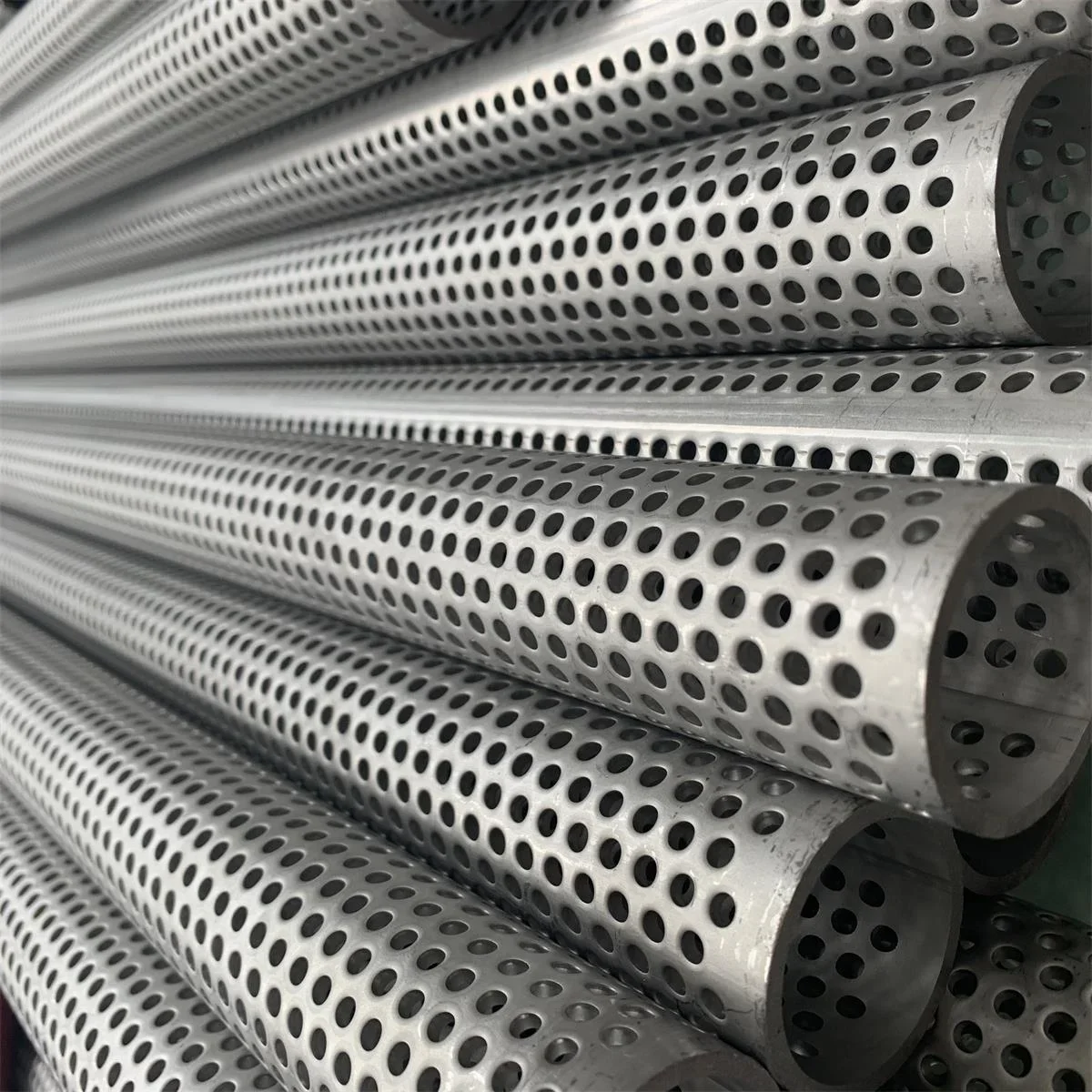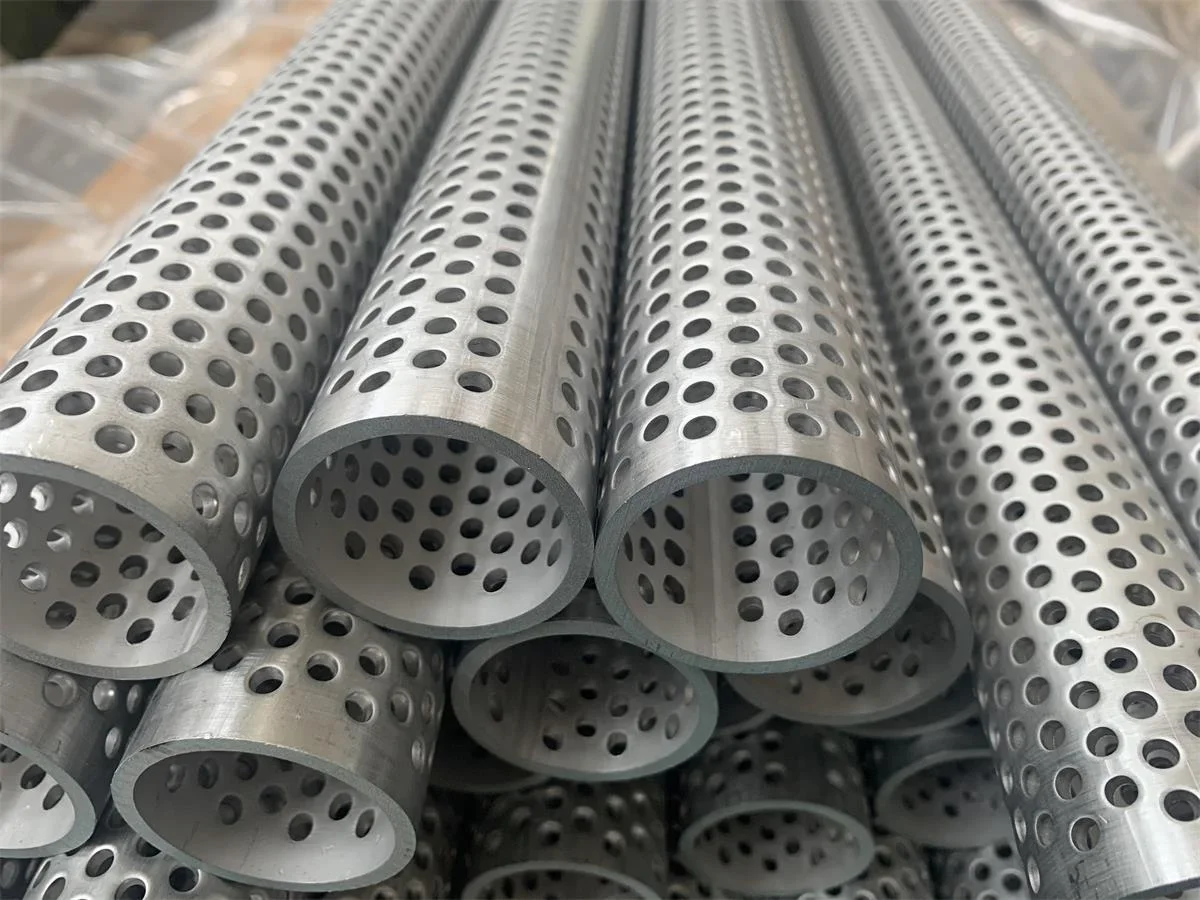Longitudinal welded perforated tubes are a versatile and widely used component in various industries. Their unique design, which includes evenly spaced perforations along the length of the tube, offers numerous applications and benefits. In this article, we will explore the diverse range of applications and the significant advantages that longitudinal welded perforated tubes offer.
I. Understanding Longitudinal Welded Perforated Tubes
A.Construction
Longitudinal welded perforated tubes are cylindrical structures made from metal or other materials, featuring evenly spaced holes or perforations along their length. These perforations can be of various shapes and sizes, depending on the specific application requirements. The tubes are manufactured by welding a flat sheet of metal into a cylindrical shape and then perforating it using specialized machinery.
B. Manufacturing Process
The manufacturing process of longitudinal welded perforated tubes involves several steps. First, a flat sheet of metal is rolled into a cylindrical shape and welded along the longitudinal seam. The welded tube is then passed through a perforation machine, where evenly spaced holes are created along its length. Finally, the tube is cut to the desired length and undergoes any necessary finishing processes, such as deburring or surface treatment.

II. Applications of Longitudinal Welded Perforated Tubes
A. Fluid Filtration and Separation
1. Industrial Filtration Systems
Longitudinal welded perforated tubes are widely used in industrial filtration systems to separate solids from liquids or gases. The perforations allow the fluid to pass through while retaining the solid particles, ensuring efficient filtration and separation processes.
2. Water Treatment Processes
In water treatment plants, longitudinal welded perforated tubes are utilized for various purposes, such as intake screens, distribution systems, and backwash filters. They help remove impurities, control flow rates, and ensure the efficient treatment of water.
3. Oil and Gas Industry Applications
Longitudinal welded perforated tubes find extensive use in the oil and gas industry for well screens, sand control systems, and downhole filters. These tubes allow for the extraction of oil and gas while preventing the entry of sand and other particles that could damage equipment.
B. Heat Transfer and Thermal Management
1. Heat Exchangers
Longitudinal welded perforated tubes are employed in heat exchangers to enhance heat transfer efficiency. The perforations increase the surface area of the tube, allowing for better heat exchange between the fluid inside the tube and the surrounding medium.
2. Air Conditioning and Refrigeration Systems
In air conditioning and refrigeration systems, longitudinal welded perforated tubes are used as evaporator coils or condenser coils. The perforations aid in the efficient transfer of heat, enabling effective cooling or heating of the air or refrigerant.
3. Thermal Power Plants
Thermal power plants utilize longitudinal welded perforated tubes in boilers and heat recovery steam generators (HRSGs). These tubes facilitate the transfer of heat from the combustion gases to the water, generating steam for power generation.
C. Acoustic Performance Enhancement
1. Sound Absorption Panels
Longitudinal welded perforated tubes are incorporated into sound absorption panels to improve acoustic performance. The perforations allow sound waves to enter the panel, where they are absorbed and dissipated, reducing noise levels.
2. Automotive and Aerospace Industries
In the automotive and aerospace industries, longitudinal welded perforated tubes are used in mufflers, exhaust systems, and soundproofing components. These tubes help reduce noise emissions and enhance overall acoustic comfort.
3. Architectural Applications
Longitudinal welded perforated tubes find applications in architectural design, where they are used in building facades, ceilings, and interior partitions. They contribute to sound diffusion and absorption, creating pleasant acoustic environments.
D. Structural Support and Reinforcement
1. Construction and Building Industries
Longitudinal welded perforated tubes are employed in the construction and building industries for structural support and reinforcement. They are used in scaffolding, formwork systems, and concrete reinforcement, enhancing the strength and stability of structures.
2. Infrastructure Development
In infrastructure development projects, such as bridges, tunnels, and highways, longitudinal welded perforated tubes are utilized for ground stabilization, drainage systems, and retaining walls. These tubes provide structural integrity and ensure the longevity of the infrastructure.
3. Mining and Tunneling Operations
Longitudinal welded perforated tubes are essential in mining and tunneling operations for ground control and ventilation systems. They help maintain the stability of tunnels and ensure proper airflow for the safety and comfort of workers.
III. Benefits of Longitudinal Welded Perforated Tubes
A. Enhanced Fluid Flow and Filtration Efficiency
The evenly spaced perforations in longitudinal welded perforated tubes allow for improved fluid flow rates and filtration efficiency. They prevent clogging and ensure the smooth passage of fluids, enhancing overall system performance.
B. Corrosion Resistance and Durability
Longitudinal welded perforated tubes can be manufactured from corrosion-resistant materials, such as stainless steel or aluminum, ensuring their longevity and resistance to environmental factors. This makes them suitable for applications in harsh or corrosive environments.
C. Customization and Design Flexibility
Longitudinal welded perforated tubes offer design flexibility, allowing for customization based on specific application requirements. The size, shape, and distribution of the perforations can be tailored to achieve desired performance characteristics.
D. Environmental Sustainability
Longitudinal welded perforated tubes contribute to environmental sustainability by enabling efficient filtration and separation processes. They help reduce waste and minimize the environmental impact of industrial operations.
E. Cost-effectiveness and Efficiency
Longitudinal welded perforated tubes offer cost-effectiveness and efficiency due to their high strength-to-weight ratio, easy installation, and low maintenance requirements. They provide long-term value by reducing operational costs and improving overall system performance.

IV. Comparing Longitudinal Welded Perforated Tubes to Other Perforation Techniques
A. Longitudinal Welded Perforated Tubes vs. Spiral Welded Perforated Tubes
Longitudinal welded perforated tubes have a higher level of precision and consistency in terms of perforation spacing and alignment compared to spiral welded perforated tubes. This makes them more suitable for applications requiring precise perforation patterns.
B. Longitudinal Welded Perforated Tubes vs. Stamped Perforated Tubes
Longitudinal welded perforated tubes offer greater strength and durability compared to stamped perforated tubes. They can withstand higher pressures and are less prone to deformation, making them suitable for demanding applications.
C. Longitudinal Welded Perforated Tubes vs. Laser Perforated Tubes
Longitudinal welded perforated tubes are generally more cost-effective compared to laser perforated tubes. They can be produced in larger quantities at a lower cost, making them a preferred choice for applications that require high volumes.
V. Installation and Maintenance Considerations
A. Proper Installation Techniques
When installing longitudinal welded perforated tubes, it is essential to ensure proper alignment and secure attachment to avoid leaks or structural issues. Following manufacturer guidelines and industry best practices is crucial for optimal performance.
B. Cleaning and Maintenance Guidelines
Regular cleaning and maintenance of longitudinal welded perforated tubes are necessary to prevent clogging and maintain their performance. Depending on the application, cleaning methods such as backwashing, chemical cleaning, or mechanical cleaning may be required.
C. Troubleshooting Common Issues
In case of issues such as reduced flow rates, leaks, or perforation blockages, troubleshooting steps should be taken to identify and resolve the problem. This may involve inspecting the tubes, cleaning or replacing damaged sections, or adjusting system parameters.

Conclusion
Longitudinal welded perforated tubes offer a wide range of applications and benefits across various industries. Their versatility, durability, and customization options make them an ideal choice for fluid filtration, heat transfer, acoustic performance enhancement, and structural support. By understanding the manufacturing process, applications, and benefits of longitudinal welded perforated tubes, industries can make informed decisions to optimize their operations and achieve desired outcomes.
Longitudinal Welded Perforated Tube: A Sustainable Solution for Agricultural Irrigation
